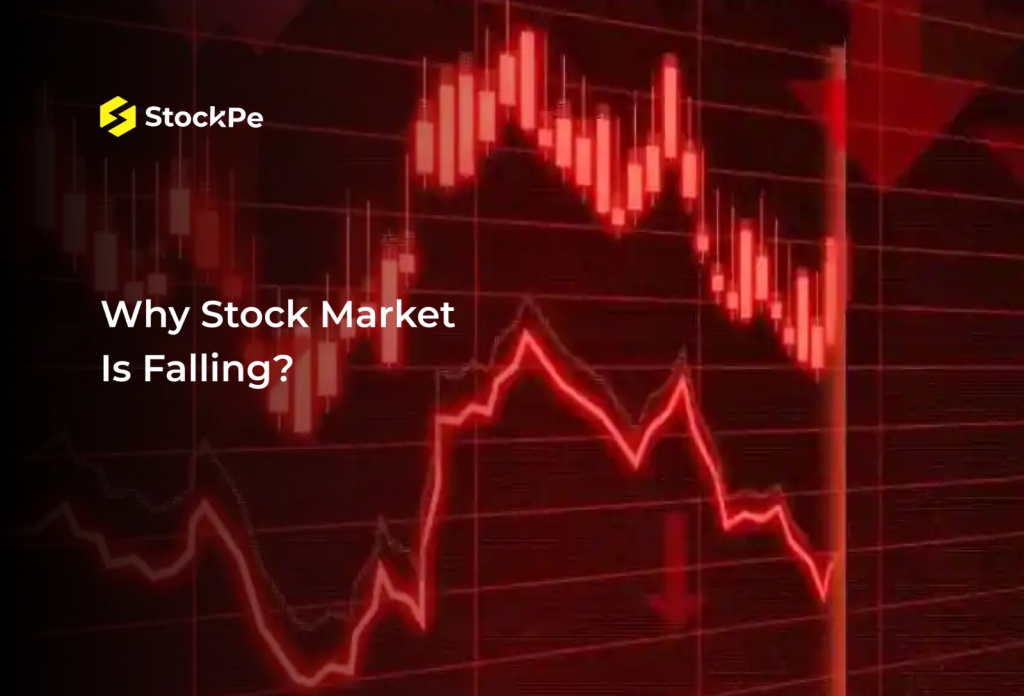A quick and unexpected drop in stock prices is referred to as a stock market crash. A significant calamity, a financial crisis, or the deflation of a long-term speculative bubble can all lead to a stock market decline. Another important factor is the public’s irrational anxiety following a stock market decline, which can lead to panic selling and more price declines.
Although there isn’t a set criterion, a stock market collapse is often thought of as a quick, double-digit percentage loss in an index of stocks over a few days. Economical effects of stock market crashes might be significant. Why does this matter? Is it decent? Bad? Depending on how you view it, that is the question. In this post, we’ll discuss what a stock market crash is, why it happens, how it affects your portfolio, and how you as an investor may deal with it.

But let’s first examine how the stock market operates.
Stock markets provide interested parties with a safe, regulated environment in which to trade shares and other financial products. Companies that need to raise more money can sell shares of their company on the stock market without giving up control of their operations. Shares and corporate bonds are available for purchase and sale, allowing investors to diversify their financial portfolios while also boosting their wealth.
Causes or Reason of a Stock Market crash:
A stock market crash occurs when stock prices fall significantly in one or more trading days. Stock markets typically experience a boom when an economy is doing well and displaying signs of promising growth. A stock market meltdown is linked to weakening financial markets and deteriorating global economies, though. Other socioeconomic circumstances may also exist that are beyond anyone’s control. When we discuss the National Stock Exchange (NSE) and Bombay Stock Exchange (BSE) as being down, we primarily mean that they are.
- Speculation:
Speculating is a common cause of market crashes. A general stock market speculative bubble led to the 1929 Crash. Following a period of excessive investment in dot-com enterprises, the early 2000s tech stock crisis occurred. Furthermore, real estate investor speculation (and banks’ facilitation of the activity) may have contributed to the 2008 financial crisis.
- Excessive Leverage:
Leverage (sometimes referred to as “borrowed money”) may seem like a useful tool when things are going smoothly. For instance, if a stock costs $5,000 and increases by 20%, the buyer will make $1,000. He would gain 2,000, double the returns, if he took out an additional 5,000 in debt to buy 10,000 worth of the same stock.
On the other side, when things are going against it, leverage may be highly dangerous. Consider a 50% loss on a similar investment of 5,000 shares. It would hurt, but there are still 2,500. If one takes out a second loan for $5,000, a 50% drop would have destroyed him. Excessive debt may result in a downward equity spiral when things go wrong.
- Rates of Inflation:
In terms of the economy, higher interest rates signify higher borrowing costs, which tends to stifle economic activity and send stocks down. As a result, if the 30-year mortgage rate increases to, say, 6%, it may dramatically slow down the housing market and lower the value of equities owned by homebuilders.
- Political Environment:
Wars and political risk are the exact antithesis of what markets value: stability. Investors become frightened about their next moves when there is ambiguity in the environment.
- Tax Changes:
Subtracting the share of nominal income that results from inflation from the tax base. With this method, the real taxable income decreases but the nominal taxable income stays the same. It will therefore make up for the effects of inflation.
These may be just a few of the many important causes, but most of the time, there are several contributing factors at play.
What influences the fluctuation of stock prices?
Stock values fluctuate daily on the stock market, which is a dynamic environment. Supply and demand-related issues are to blame for this. There is a greater demand for a stock if there are more people wanting to purchase it. That stock’s price increases concurrently. on contrast, there is a bigger supply of the stock than there is demand for it on the market if there are more people looking to sell a stock than there are people looking to acquire it. The stock price drops as a result of this.
Bull Market and Bear Market Interaction:
When an economy is overheated, inflation is on the rise, market speculation is rife, and there is a great deal of uncertainty about the direction of the economy, the stock market often collapses. Because of these factors, stock market declines usually start off slowly and turn disastrous as investors look for a quick way out or to stop. Due to the high interaction between the bull market, bear market, and stock market bubble, it may tumble in undesirable ways.
Understanding supply and demand is simple for a trader or investor. Reasons to buy a specific stock or to dislike a different stock enough to wish to sell it, on the other hand, are harder to fathom or understand. This primarily involves identifying which news items are advantageous to a corporation and which are unfavourable. Every investor has different ideas and approaches to dealing with this complex situation.
- Bull Market:
This is when supply outpaces demand, investors are optimistic about the market and the economy, and share values are on the rise. It might last for two to nine years. A significant market event is all that is necessary to start a confidence crisis and draw more sellers to the market.
- Bear Market:
This phenomenon typically develops after a stock market crash. In this scenario, investors start to lose hope and start selling their shares, which lowers prices as supply overtakes demand. When the value of the stock market drops by 20% over the course of 52 weeks, it is referred to as a bear market. It often only lasts four years or less.
Interest rates and Federal Reserve Rate Hikes or get increased:
The Federal Reserve’s decision to raise interest rates is one of the main causes of the current stock market drop. The cost of borrowing money increases when the central bank raises interest rates for both firms and consumers. This may result in lower consumer spending and possibly slower economic expansion, both of which have an impact on business profitability. As a result, investors might become more cautious, which would cause the equities market to decline or downfall.
Market interconnectedness and global economic conditions and circumstances:
In the current interconnected global economy, developments in one region can have significant effects on markets elsewhere in the world. The recent stock market drop is a phenomenon seen on many and many internationals equity markets and is not only restricted to one nation. Asian markets, for instance, have also experienced significant drops, reflecting the general sense of unease.
Market sentiment may be impacted by factors related to the global economy, such as supply chain interruptions, inflationary pressures, and shifting trade patterns. Geopolitical developments and trade disputes between major economies can amplify the anxiety, causing investors to seek out safer investments and possibly triggering a sell-off in stocks.
Implications for Individual Stocks and Investors:
Although market indices like the Sensex and Nifty offer a broad overview of market performance, individual companies are also affected by adownturn in the stock market. It may be difficult for businesses to raise funds and invest in growth projects as a result of the decrease in stock prices because valuations may be impacted. In a volatile market environment, businesses may also have trouble luring investors and lenders.
While falling stock prices may result in paper losses, it’s crucial to keep the big picture in mind. Markets have historically bounced back from downturns, and well-diversified portfolios have proven durable over time. During market downturns, savvy investors may also spot discounted possibilities, positioning themselves for possible gains once markets recover.
The Bottomline:
A number of variables have come together to cause the current stock market slump that has been seen on numerous international markets, including the S&P 500, Sensex, and Nifty. The current market environment has been shaped in part by Federal Reserve interest rate increases and expectations, changing market mood from bull to bear, global economic conditions, and interconnected markets. Although the fall has effects on certain stocks and investors, it is crucial to view market changes in the long run. Keep in mind that market cycles are a normal aspect of investment, and careful risk management techniques can ease the way through challenging times. Investors looking to navigate the turbulent financial markets must be vigilant and adaptable as economic conditions change and major world events take place.





